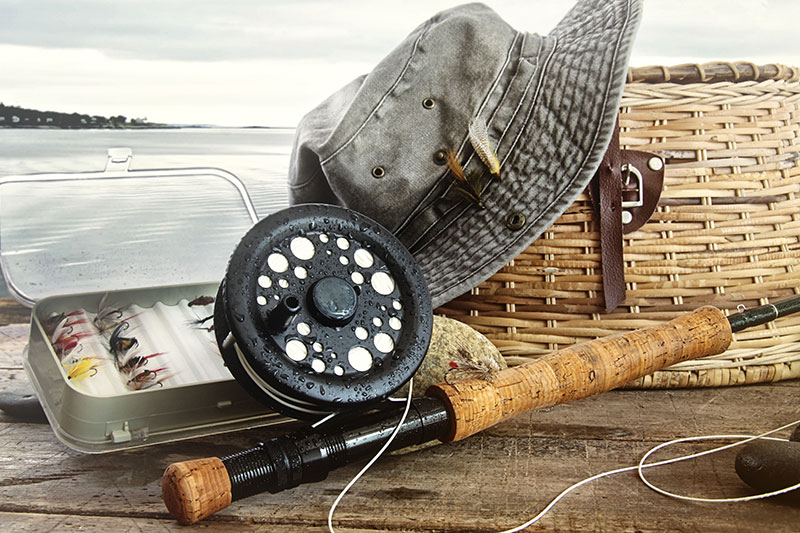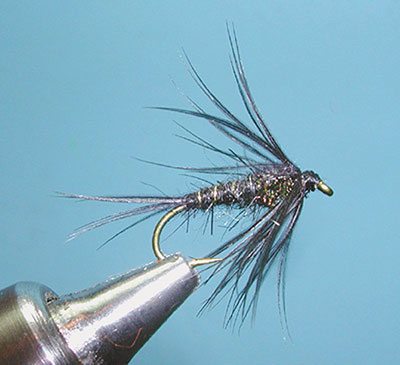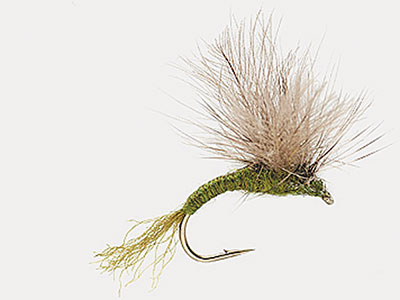
All-Purpose (AP) Emerger Black
I never go near lakes or moving water without these two patterns in my fly box. They have proven to be deadly over the years, and I find it especially effective for any species of trout when they home in on emerging insects feeding in the top few inches. It does an excellent job matching emerging mayfly, caddis, dragon fly nymphs and water boatman. This fly was developed by stillwater specialist Denny Rickards of Fort Klamath, Oregon in the early 1990’s.

AP Emerger #1
I like to fish this fly with a Camo intermediate line with a 12- to 15-foot knotless 6X leader and small diameter fluorocarbon tippet 5X to 6X. Trout are constantly on the move, changing locations, depths and feeding patterns. This fly line has the uniform density to take the fly into the richest food-bearing region of the lake, which is usually between two and eight feet. The line sinks at a rate of 1½ inch per second. This rate allows one to do a slow retrieve through the water column. A short slow pull and pause retrieve or with a rapid two inch pulls closely resembles the slow natural movements of most aquatic insects found in lakes. The key to the retrieve is to do it slow.

AP Emerger #2
Suggested Tippet to Hook Ratio
Tippet Diameter Hook Size
.011 (0X) 1/0-4
.010 (1X) 4-8
.009 (2X) 6-10
.008 (3X) 10-14
.007 (4X) 12-16
.006 (5X) 14-22
.005 (6X) 16-24
.004 (7X) 18-28
.003 (8X) 18-28
Material
Thread: Black 6/0
Body: Black Hairs Ear
Thorax: Peacock Herl
Tail: Mallard Flank Dyed Black
Rib: Copper Wire
Wingcase: Mallard Flank dyed Black
Hackle: Partridge dyed Black
Second option
Thread: Black 6/0
Rib: Small Copper Wire
Body: Dark Wool
Thorax: Peacock Herl
Hackle: Pheasant Rump
Tail: Pheasant Tail
Cul-de-canard (CDC) Mayfly Emerger
In the emerger phase, mayflies easily become trout’s prey; it’s always a better meal choice for a trout than a dry fly due to least effort, most calories. If you see dry flies on the surface and trout rising but not taking them in, most probably a trout is grabbing those emergers subsurface.
You can tell if trout is feeding on emerger by the way they rise and what you see showing above water. If you do not see the head, and only see the dorsal fin, then a tail with a splash, it is most likely the emerger in the trout’s mouth. CDC is the perfect material for creating an emerger fly pattern. Tied in a number of species colors and sizes, this fly pattern sits in the film with the body hanging down and the CDC feathers just above the surface, offering a great representation of an adult emerger.

CDC Mayfly Emerger
For presentation, dry fly drag-free drifting is most effective. An occasional slight drag could produce a strike as it brings the fly close to the surface, but keep it as short as possible. I use it for exploring depths of two to six feet when no insect activity is present. This pattern is best fished on the Camo intermediate line in sizes 10 or 12 with jerky four- to six-inch pulls. This is a good fly for dark days, rippled or offcolored water.
Note: Cul-de-canard is a wonderful material for both tying dry or emergers. The feather comes from around the uropygial gland, informally known as the preen gland or the oil gland, a bilobate sebaceous gland possessed by the majority of birds. It is located dorsally at the base of the tail and is greatly variable in both shape and size of a duck. Its fibers contain many tiny filaments impregnated with the natural oil of the duck, so it floats superbly.
Material
Thread: Olive 6/0
Body: Olive Dubbing
Thorax: Cul-de-canard
Tail: Cul-de-canard
Visit the Store
$34.99
$34.99
Featured Catch

Joel Unickow halibut (Photo: Rob Frawley Lucky Strike Sportfishing Tofino)







